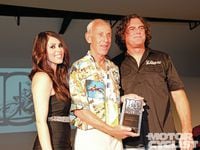How did it get so late so soon?
It’s night before it’s afternoon,
December is here before it’s June,
My goodness how the time has flewn!
How did it get so late so soon?
That poem, written in the autumn of life by a reflective Theodor Geisel—you know him as Dr. Seuss—pretty much sums up my 25 years as a moto-journalist. It seems like just the other day I was scribbling notes between races at Willow Springs, then typing them—on an actual typewriter—into something that passed as a Cycle News race report.
Much has changed in that time, in motorcycling and in publishing. When I started at “America’s Weekly Motorcycle Newspaper” in 1988, we were the only show in town. Aside from the monthly magazines, there was no other motorcycle media.
Television coverage changed that. Suddenly, race fans were able to find out who won long before the magazines hit their mailboxes. Only diehard enthusiasts continued to subscribe to racing publications like American Roadracing, which I edited in the early '90s.
The Internet accelerated that trend. This sea change wasn't lost on publishing companies, which re-branded themselves as media outlets. Nowadays, in addition to print features, journalists are expected to write web stories, update social media pages, shoot and edit videos, etc. Computers were supposed to make our lives easier, but sometimes it seems they just increase our workload!
Truth be told, I interviewed at Motorcyclist a number of times, first with Art Friedman, then with Mitch Boehm. When I finally came on board in 2005, I couldn't have imagined what lay in store. Barely a year later, the company hired Group Editorial Director Alex Hearn, who promptly promoted me to Editor in Chief. Alex then hired his former art director, Darren Scott, and the two of them redesigned Motorcyclist to resemble the magazine they'd published in the UK, TWO. I remember Alex wondering why, on the rare occasion we printed foul language, we disguised it as @#$%. It took just one issue of us spelling those words out for him to understand why!
Fortunately, through all of these changes, there continued to be enthusiasts willing to subscribe to a well-written motorcycle publication. And together with Executive Editor Tim Carrithers, Editor-at-Large Aaron Frank, Road Test Editor Ari Henning, Managing Editor Andreanna Ditton and Art Director Joe Neric, we fine-tuned the magazine into what it is today. Often we heard from readers who remarked that Motorcyclist was better than it had ever been, better even than Cycle World— music to my ears. That made all the hard work worthwhile.
Almost: A quarter-century of monthly deadlines was taking its toll on me, and I realized that I couldn't go on forever. I'll be the first to admit I had "the best job in the world," but it was never easy, and got much more difficult after the economy tanked circa 2008. With advertising and newsstand revenues down, we lost our our behind-the-scenes support staff, and our operating budget was slashed. And there was constant turnover: In the seven years I worked at Motorcyclist, we had seven publishers—you do the math—and were owned by two different companies. With each of these regimes having its own agenda, I witnessed more false starts than in an entire lifetime of racing. Motorcycle magazines can be great work but they're tough businesses.
Knowing that 2012 marked Motorcyclist's centennial, I vowed to remain at the helm until our commemorative September issue. After hosting the gala affair at which we presented the Motorcycle and Motorcyclist of the Century, the following workday was my last.
Standing on stage that evening as Publisher Dave Sonsky announced that I was retiring, I had no regrets. It’s been a whirlwind career, traveling the world and riding hundreds of motorcycles. And in the end, I was privileged to usher the world’s oldest motorcycle magazine into its second century. The time sure had “flewn,” but I was truly going out on top.











/cloudfront-us-east-1.images.arcpublishing.com/octane/VZZXJQ6U3FESFPZCBVXKFSUG4A.jpg)
/cloudfront-us-east-1.images.arcpublishing.com/octane/QCZEPHQAMRHZPLHTDJBIJVWL3M.jpg)
/cloudfront-us-east-1.images.arcpublishing.com/octane/HXOUJXQWA5HBHGRO3EMJIGFMVI.jpg)

/cloudfront-us-east-1.images.arcpublishing.com/octane/3TIWWRV4JBBOLDVGRYECVVTA7Y.jpg)
/cloudfront-us-east-1.images.arcpublishing.com/octane/KIX5O23D5NAIBGFXBN3327DKZU.jpg)
/cloudfront-us-east-1.images.arcpublishing.com/octane/7GJYDUIPXRGMTMQKN6ONYOLBOU.jpg)
/cloudfront-us-east-1.images.arcpublishing.com/octane/MUQLOVLL2ZDGFH25ILABNBXKTI.jpg)
/cloudfront-us-east-1.images.arcpublishing.com/octane/TNOU5DNE2BC57MFPMGN2EIDXAM.jpg)
/cloudfront-us-east-1.images.arcpublishing.com/octane/GTCXACQGJ5HAPDTGWUQKDEH44E.jpg)
/cloudfront-us-east-1.images.arcpublishing.com/octane/S35YGSEMEZB4BLTDJTSZPF4GLA.jpg)
/cloudfront-us-east-1.images.arcpublishing.com/octane/5UOT6HPX2JFMRJAX6EH45AR4MQ.jpg)
/cloudfront-us-east-1.images.arcpublishing.com/octane/OKWOJWAKP5EP3OACCRRWPCIX2Q.jpg)
/cloudfront-us-east-1.images.arcpublishing.com/octane/2WF3SCE3NFBQXLDNJM7KMXA45E.jpg)
/cloudfront-us-east-1.images.arcpublishing.com/octane/G4MG6OUCJNBSHIS2MVVOTPX65E.jpg)
/cloudfront-us-east-1.images.arcpublishing.com/octane/IIGGWFOTOJGB7DB6DGBXCCMTDY.jpg)
/cloudfront-us-east-1.images.arcpublishing.com/octane/QSTCM6AVEZA5JJBUXNIQ3DSOF4.jpg)
/cloudfront-us-east-1.images.arcpublishing.com/octane/U4I7G625B5DMLF2DVIJDFZVV6M.jpg)
/cloudfront-us-east-1.images.arcpublishing.com/octane/B6XD6LS6IVCQPIU6HXDJSM3FHY.jpg)
/cloudfront-us-east-1.images.arcpublishing.com/octane/ICL63FEDDRDTTMINYICCEYGMDA.jpg)
/cloudfront-us-east-1.images.arcpublishing.com/octane/FCGZHQXRBZFLBAPC5SDIQLVF4I.jpg)
/cloudfront-us-east-1.images.arcpublishing.com/octane/WNOB6LDOIFFHJKPSVIWDYUGOPM.jpg)

/cloudfront-us-east-1.images.arcpublishing.com/octane/X33NU3E525ECRHXLNUJN2FTRKI.jpg)